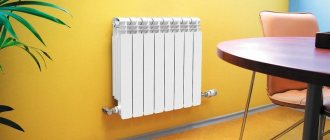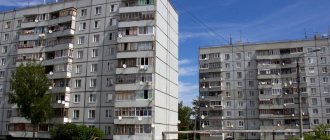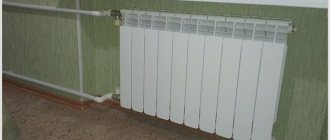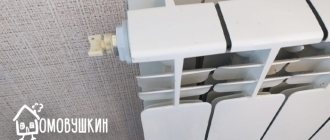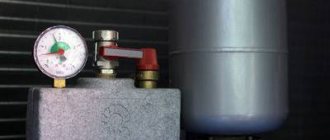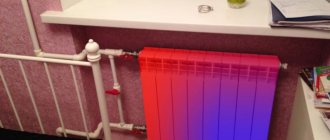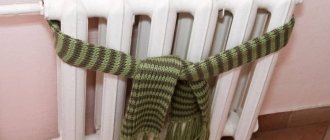It happens that the heating system malfunctions, and a situation arises - the boiler is working, but all the batteries, or at least part of them, are cold. Let's look at a dozen reasons for this state of affairs, how to fix the breakdowns yourself, without involving...
It's easier with automated boilers
If the boiler is automated, gas or electric, then, as a rule, the automation will not allow overheating of the coolant in the boiler itself when the supply to the batteries for some reason stops. The protections will turn off the device, show an error code, then you need to draw conclusions from this information.
A breakdown of the boiler itself can be repaired by service. It is not recommended to open complex equipment yourself.
Cold radiators, when an automated boiler is running, may occur not only due to the breakdown of complex equipment, but also because... (the most common reasons).
- Air pockets in radiators and on U-shaped elevations of the pipeline. Bleed the air using Mayevsky's taps. Install air vents; if they are not there, convert the system to “normal”.
- Clogged filter, silting of the lower section of the pipes. Check the return filter at the boiler inlet.
Wrong system
For example, in a parallel circuit, if the installation rules are violated, the middle radiators in the ring may turn out to be cold when the boiler is running. Eliminated by balancing or rewiring. Why does the passing scheme not work?
The following is also possible:
- The valves are closed - check the valves, including tuning and balancing valves, which regulated the flow along individual dead-end branches, to individual radiators.
- A sequential battery connection scheme was used, in which the last radiators in the pipe are always colder or do not heat up at all... Rework, use modern circuits.
- Various complex inclusions of radiators, “where everything is confusing.” Remodel and use conventional two-pipe heating systems - dead-end, passing, radial with the presence of balancing valves...
Pipe problems
Polypropylene pipes can create a surprise. When welding them, the internal clearances are not controlled. The installer does not guarantee anything. It’s not uncommon for the boiler to heat up, but the polypropylene system is not working properly, some of the batteries are colder for some reason, some are disconnected... First of all, start resoldering and finding the bottleneck. Or replace the pipes with more reliable ones.
- In any system, there is debris in the coolant. If there are U-shaped depressions in highways, there may be congestion.
- Perhaps just old steel pipes? Their service life is limited; from the inside they become overgrown with deposits and heating stops.
In systems without automation
There is a threat of a serious accident, destruction of the boiler if it is working and the batteries are cold. In a solid fuel heat generator, if the fuel is burning, the liquid in the heat exchanger will boil very quickly if there is no circulation and heat removal, i.e. if the heating system remains cold.
This is not an acceptable situation, which is prevented by installing an uninterruptible power supply for the circulation pump. And also by regularly checking the filter.
First of all, in such systems the operation of the circulation pump is checked, which is often located on the return line near the boiler.
Complex systems - what is the solution
Nowadays there are more and more complex heating systems. Such piping of a private house can be divided into several independent circuits, each of which has its own circulation pump. For example: - radiators of a house, heated floors in a house, an indirect heating boiler, a greenhouse, a garage and a workshop, an outbuilding, and a separate attic.
It’s not uncommon for something like this to be connected to a couple of working boilers (the backup one doesn’t count).
In order for a complex circuit to work stably, all these circuits must be connected to some kind of distributor, which would provide them with the same initial stable pressure, regardless of the operation of neighboring circuits. In complex systems (more than 4 circuits) this is done using a hydraulic arrow or a primary circulation ring of pipes.
Incompetent design or installation under such circumstances leads to the fact that some of the pipelines and batteries remain cold when the boiler is running. Those. one circuit influences the other. The solution is to create a competent scheme.
Situations in apartments
In apartments with central heating everything is simpler. The heating circuit there is not complicated - one or more radiators are connected in parallel to the risers.
- If the riser is cold, it means that the air at the top has not been vented, or the distribution along the risers has not been adjusted. In any case, you need to contact someone to bleed and adjust...
- If the riser is hot and the edge of the battery is cold, then there can be two reasons - the batteries are airy, and you need to bleed the air yourself. Or - a small pressure on the riser - you need to understand it as in the previous paragraph.
- There is also a common problem in apartments - clogging and overgrowing of old cast iron radiators. It also happens that it’s time to change them for new ones, otherwise nothing will help...
How does a boiler work?
To understand the situation more clearly, you need to understand the principle of operation of the boiler. Double-circuit gas wall-mounted boilers such as Baksi or Ariston consist of several components. In the gas part, the incoming fuel is burned, the water part ensures the supply of heated water from the heat exchangers to the heating system, and the smoke removal part is responsible for removing combustion products outside the home.
Depending on the user settings, temperature sensors adjust the water heating mode. A sensor on the return pipeline turns off the boiler, depending on the achievement of the required temperature set for the return. However, the system pump does not stop running until the heat exchanger temperature drops.
This is provided to prevent the water from boiling in it. As soon as the coolant cools down to the maximum level, the electronics will send a signal to turn on water pumping and the gas valve. The whole process will start again. When you open the tap in the mixer in a double-circuit boiler, a flow sensor reacts, which informs the electronics about the need to switch the three-way valve to the mode of heating water for DHW.
When the hot water tap is turned off, it returns to heating mode. Some manufacturers provide heating for both heat exchangers during periodic switching.
Mismatch between the volume of water and the power of the boiler used
The volume of coolant must correspond to the speed at which the boiler heats the water. Otherwise, by the time the water passed through the pipes returns in a cooled state, the boiler will not have time to warm up the entire volume that is in the system.
For example, a volume of water of 300 liters for a heating system does not correspond to the power capabilities of an 8-kilowatt boiler. Such a boiler will not turn off, it will work continuously, but will not be able to reach the required temperature.
The boiler does not heat water for heating
So, let's look at the main reasons why a gas boiler does not heat water for the heating system and what to do about it:
- airlock. It is necessary to inspect the heating system for the presence of air in the radiators. To eliminate this problem, you need to install an air vent. Its operating principle is similar to that of an expansion tank, but it is capable of maintaining pressure in the system. Using an air vent, you need to bleed air from the system. It is important to inspect the valve itself for mechanical blockages - scale may be present there;
- corrosion in radiators. Clogging of heating devices can be determined by draining water from the system. If the water flows dirty, then you need to flush the system until visually clean water appears;
- connection errors. Hot water may not flow if the diameter of the pipes is not as specified in the project or instructions. It is necessary to check the compliance of the pipeline, the correct connection and the quality of installation of shut-off valves;
- insufficient pressure in the network. You should try adding water to the heating system, as there may not be enough pressure to trigger the automatic ignition of the burner;
- presence of scale in the heat exchanger. The first sign is prolonged heating of the coolant and heating of the batteries. It is necessary to get rid of sediments and carry out boiler water treatment. To do this, you need to disassemble the boiler and remove the heat exchanger assembly.
Before doing this, you need to shut off the flow of gas and water to the device. Then flexible connectors from the pump are connected to the heat exchanger and it is washed with a composition containing a special cleaning agent, which can be purchased over the counter. After which the parts are washed with water.
Some manufacturers allow the use of antifreeze instead of water in the heating system. This substance can be used in the following boilers: “Baxi”, “Vaillant”, “Proterm”, “Beretta”, “Korea Star”. However, it should be understood that each manufacturer recommends using its own antifreeze;
- filter clogging. If the filter screens are clogged with mechanical debris, the radiators may also have poor heating. Therefore, the filter should be checked and cleaned regularly by rinsing with water. If clogging occurs too often, then such a part must be replaced;
- incorrect setting. First of all, if there is weak or no heating, you need to check the settings of the control unit. The temperature may be set insufficiently and the gas does not heat the water;
- malfunctions of pumping equipment. If the pump power is not enough to ensure good circulation, it may turn off if it overheats. This can happen when the DHW circuit is turned on;
- incorrectly selected heating devices. If the system has radiators with unsuitable heat transfer and design parameters, this can also lead to low heating;
- incorrect slope of pipelines. Most often this problem occurs in systems with natural circulation. Regulatory documentation specifies that the slope of pipes should be 10 mm per meter of pipe. If these requirements are not met, circulation may be disrupted and, as a result, there may be no heating due to low coolant flow.
Too much draft in the chimney
Increased draft occurs in tall, insulated chimneys with good supply ventilation. The optimal air exchange rate in the boiler room is three, i.e. The air is changed three times within an hour. With increased draft, the air in the boiler room changes up to 10-15 times. In this case, the flame does not burn, but is literally blown away with a gust of air. Thus, the boiler does not heat the coolant to the required temperature.
You can adjust the draft by using a damper, but not all old models of floor-standing boilers have dampers in the chimney to regulate draft, which cannot be said about modern devices. Manufacturers are constantly modernizing boilers, and new models have built-in draft regulators. Despite the fact that this reason is less common, experts still recommend that when choosing equipment, pay attention to the presence of an option for adjusting traction.
The boiler does not heat water for hot water supply
In addition to the lack of heating of the heating system, it happens that the gas boiler does not heat the hot water supply circuit.
After all, scale has a structure that limits the passage of coolant and also takes away its heat. This is due to the thermal conductivity of salt deposits - it is much lower than the thermal conductivity of the metal from which the heat exchanger is made. Therefore, the boiler does not heat hot water well.
It is also possible that a piece has come away from the salt deposit, blocking the flow completely, which leads to a complete stop in the supply of hot water.
Structurally, the sensor is a paddle device through which water flows, which is the condition for its operation, because it sends a signal about the presence of a flow to the electronics, which, in turn, starts heating the water again. It happens that the sensor gets clogged, but it can be cleared of the blockage without removing it.
The device has the shape of a cylinder and is located near the circulation pump. To start cleaning, open and close the tap near the sensor. If this does not help, then it should be unfastened and removed, cleaned by hand and reinstalled. If this does not help, then the sensor is most likely faulty and needs to be replaced.
It is designed to shut off the heating system when the hot water tap on the mixer is opened. If the valve does not work, the boiler does not switch to heating water for DHW from heating water for heating. The first reason for its failure may be clogging with corrosion products, which needs to be removed.
If this does not help, the valve should be replaced. The hose system and filter may also become dirty. This problem is barely noticeable on the heating circuit, but on the hot water supply circuit it will be more noticeable. These elements need to be cleaned.
There are frequent situations when the problem of a heating battery not heating arises. Sometimes you have to rack your brain in search of the reasons why the situation is happening and how to fix it. We have collected for you 7 possible reasons why radiators may not heat up and offer to study each in detail.
Important! This article is especially relevant when starting heating systems. Many, like you at the moment, may be experiencing difficulties with batteries. Your repost of our material may help someone quickly solve their problem. Don't forget to click on the social buttons. networks at the very bottom of the article!
Where to go if the radiators are a little warm, but there is no trust in local housing and communal services representatives
After submitting a claim, you can wait a week, unless cold weather and life circumstances (for example, the presence of small children or weak health members in the family) force you to act earlier.
If there is no proper response, such a complaint should be sent to a higher authority - the district housing inspection or Rospotrebnadzor. To the document it is necessary to add information about the actions taken previously, a copy of the first statement, reporting the lack of an appropriate response from the FSW.
In case of repeated silence, the next authority will be the prosecutor's office. The submitted complaint must be accompanied by documentary evidence of the futility of previous attempts to resolve the issue and provide information about the harm caused by the inaction of officials to residents of the apartment.
You can also go to court, but cases are not considered quickly and it is better to go there after resolving the main part of the issue, presenting a claim for compensation for material and moral damage.
Citizens faced with such difficulties often express the opinion that it is useless to contact the local housing and communal services, advising them to act immediately through higher-level authorities or send the original complaint to the management company, and at the same time copies to all other regulatory organizations.
Each case is individual, and it is impossible to make unambiguous prejudicial judgments about all organizations of this kind. The scale and intensity of action taken depends on many factors. How persistently and where to complain about cold batteries, what to do in a particular case - everyone decides for themselves.
Bypass
The bypass is the same pipe that stands in front of the installed heating device. Everyone has one, it’s needed to bypass water past the battery. If installed incorrectly - too far from the radiator, or in line with the central riser, it does not allow water, which tends to travel along the shortest path, to circulate normally, heating the radiator sections. In this situation, they will either not heat at all or will be very bad. Check how your bypass is installed. Perhaps this is the direct reason why the batteries do not heat up
Incorrect battery connection
Incorrect or ineffective connection of the radiator is also the reason for its poor heating. The best option is to supply water to the top hole of the battery and exit through the bottom. In this case, both connections must be on the same side.
Options for connecting the battery to the system
The cross method involves the return outlet on the other side of the radiator. This is also an efficient option that allows only 2% heat loss. There are other connection options, but they have more noticeable losses.
Incorrect radiator connection
An incorrect connection can completely deprive you of heat . This includes the case when the supply is installed in the lower hole, and the outlet in the upper. If such installation errors occur, they should be eliminated as soon as possible.
Three way valve
Such a tap is required to switch the bypass-battery direction. If this is the reason that the radiator does not heat, then the problem can be eliminated in 3 ways:
- No disassembly. In cases where the tap turns easily, but switching does not occur at all (neither one nor the other works), you can try to develop the device using multiple turning movements. In this case, blockages, as a rule, are washed away by the flow, going into the riser. The operation of shut-off valves is restored in full.
- With partial disassembly. There's no way to turn the tap? We're not trying to break it. Carefully unscrew the locking screw of the handle, remove it, place the screw back in order to prevent deformation of the part during further work. Further actions are carried out with a wrench. It is not recommended to use round nose pliers, pliers, etc. The reason is the same as with the screw - not to damage the rod. Holding the rod with a wrench, we smoothly rock it back and forth, starting with minimal vibrations. If you cannot make minimal movements, slightly loosen the large hex nut that presses the stuffing box seal. If it starts to dig in, place a small container. Continuing the work, moving the rod, press the seal into place, turning the large nut back accordingly. We unscrew the screw, install the handle, screw in the screw, and rejoice.
- In rare cases, when the internal stop is simply torn off, the crane has the ability to “spun in a circle” endlessly - we simply select the position of the handle in which normal operation is ensured.
Poor quality connection to the gas pipeline
If, during gas flow, the installation was performed poorly, the needle on the pressure gauge may not reach the desired mark.
To conduct gas, a thread is usually welded (especially in cases where workers do not want to connect a large section of the gas pipeline) and a tap is screwed in, resulting in a welded thread with a tap. The tap is opened and a hole is made with a drill. If the drill is of small diameter, and as a rule, the drill is much smaller than the pipe, the hole is obtained with a small throughput.
A sign of poor-quality tapping into the gas pipeline may be a sharp decrease in the flame immediately after the boiler is ignited. The flame may go out completely, or the boiler simply will not begin to gain temperature.
Human factor
A person can also become the direct cause of a non-heating radiator. And usually they are as follows:
- A riser that they simply forgot to turn on because “it was late and the plumbers were tired.”
- Closed valve of the automatic air vent system.
- Incorrect connection during installation.
- Child-closed three-way valve.
They can be solved by calling the appropriate support service, correctly connecting the battery (or bypass, see below), and carefully checking the taps.
Reasons for the battery not heating up
Air locks are the main reason for insufficient or uneven heating of radiators, but there are other reasons for this unpleasant phenomenon. These include :
- Poor circulation of coolant through the system pipes.
- Incorrect battery connection (for example, when the supply is connected to the bottom hole and the return to the top).
- Clogged inside the pipes and the battery itself.
Let's consider each possible option in more detail.
Flow extender
A typical problem for a two-pipe system. Is it possible to make any number of sections? It is possible, but the very last sections of the battery will not warm up. Cause? Water, like a person, looks for “where it’s easier” and follows the shortest path. In order to “teach order” to the lazy one - water, a flow extender is required. Factory-made, or made independently from a piece of pipe. By directing the fluid to the middle of the structure, it will force the flow to circulate correctly, reaching the farthest ends of the heat exchanger.
Interesting fact: the same problem can be solved by connecting the heating device “diagonally”. But this is rarely used, due to the lack of aesthetics of this solution on ready-made systems.
Hotlines for heat issues in citizens' homes
In large cities it is easier to find where to go if the batteries are a little warm. This issue can be resolved through unified dispatch services that have regional offices (telephone numbers can be found through local authorities or help desks). The call must be responded to on the day it is received.
If they didn’t respond to the complaint or couldn’t help for some reason, and the radiators in the apartment are cold, where should I go and what should I do?
Residents of the capital, for example, should contact the Moscow Housing Inspectorate. The service line numbers are listed on the official website. You can call to solve urgent problems related to heating in Moscow at any time of the day.
In 2022, the Moscow United Energy Company launched its rapid response telephone line. The phone number is published on the official website of the organization. In this case we are talking about Moscow.
Where to go if the radiators are a little warm, and the housing is in another city? It makes sense to call the thematic hotline in your region, stating over the phone your complaints about the condition of your housing.
Balancing valve
Privately owned houses have the greatest variety of heating systems. Cases of two or three branch structures are not uncommon. In this case, as in the above cases, the tendency of the liquid to take the shortest route naturally remains. The longest arm may have no circulation at all or very weakly expressed. The heat transfer of such a link will be the same - small, absent. The battery will not heat or heat poorly.
Silt at the bottom
The water in central heating systems is of poor quality. Sediment falls out of it, forming a layer of sludge at the bottom of the radiator. When using low-quality or incorrectly selected coolants, the same thing happens.
As sediment accumulates, the throughput of the lower collector decreases. Less coolant passes through the heating radiator, it cools down quickly. Heat transfer decreases.
The problem can only be solved by flushing the radiator. To do this you need:
- Shut off the supply and return;
- Unscrew the radiator from the incoming and outgoing pipes;
- Wash it with special means.
We described this in more detail in the articles How to flush a heating radiator and How to remove a heating radiator without consequences.
Clogged radiator
Sometimes the reason that the radiator does not heat can be a simple blockage. When determining the causes of blockage, let’s highlight the symptoms:
- It only warms around the perimeter.
- Only the top part.
- The bottom is heated, the top is not.
- Only a few sections out of all possible provide heat (if the bypass location is correct)
Could it be just the old battery that is clogged? Not at all. New systems (modern and ultra-modern, aluminum and cast iron) suffer from this just as often. The problem may lie in the general contamination of the system:
- From long-term use.
- Due to installation errors.
- Sediments with high water hardness.
- Erosion of system elements (oxide, rust).
How to get rid of it?
Modern heating devices with properly installed shut-off valves include an “American” valve, by turning off which the non-working part can be easily dismantled and cleaned, purged, and washed under pressure.
It’s harder where the equipment is “countless years old.” To disassemble, you may have to turn to specialists, emptying (preliminarily or with their help) the entire volume (usually just water).
Cast iron radiators can be cleaned. It is recommended to replace steel flat flow welded radiators with new ones of other models. But it is they, ironically, that are most often susceptible to rusting and clogging of channels - due to the design features and materials used. Therefore, they often do not heat properly. An additional reason not to clean this type of heating device is the risk of leakage of the eroded wall due to its thinning in the process of peeling off oxidized metal flakes. A leak can be costly (even if you forget about the cost of repairing the “junk”). This is the same case when the stingy one has every chance to pay twice, or even three times.
Interesting fact: cast iron radiators clog 3-5 times less often than aluminum or stamped ones.
The riser is blocked
The reasons when the riser in a multi-storey building is blocked affect all residents who live in the “disaster area”. In fact, unauthorized blocking of the riser can be done by one of the residents out of ignorance. In any case, with such an overlap, there is a need for the intervention of regular plumbers to clarify and fix the problem. Of course, this causes the batteries to become cold.
More frequent causes of a blocked riser occur after any repairs have been carried out that required such a blocking. Each riser of a multi-apartment multi-storey building is equipped with shut-off valves at the top and bottom. Carrying out repairs in which both the upper and lower taps are closed requires special permission.
At the end of the repair, the specialists could simply forget to turn the riser back on to normal mode. If, in the user’s opinion, the riser is blocked, then you should contact the relevant organization and find out the details. You should not attempt to restore the riser operation without permission.
